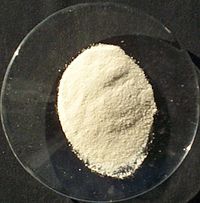
Photo from wikipedia
Abstract Tetravalent metal oxides, such as ceria and zirconia, are widely used as support materials in a broad range of heterogeneous catalytic processes. Herein, high-surface-area CeO2-ZrO2 composite supports with micro/mesoprous… Click to show full abstract
Abstract Tetravalent metal oxides, such as ceria and zirconia, are widely used as support materials in a broad range of heterogeneous catalytic processes. Herein, high-surface-area CeO2-ZrO2 composite supports with micro/mesoprous structures were first fabricated successfully by a low temperature solution-phase method without the use of any additional templates and surfactants and resulting supported platinum nanoparticles were employed in liquid-phase selective hydrogenation of cinnamaldehyde to cinnamyl alcohol, a key reaction for the production of important chemicals. It was found that the component of CeO2-ZrO2 composites strongly influenced surface structures of catalysts, and consequently determined the nature of platinum species and the catalytic properties of catalysts. When platinum was dispersed on the CeO2-ZrO2 composite with the Ce/Zr molar ratio of 1:1, a high cinnamyl alcohol yield of 89%, together with an extremely high turnover frequency value of 10423 h–1, could be achieved without the use of additional alkali. Such high catalytic performance, which was superior to those of most known supported Pt-based catalysts previously reported, was mainly attributable to the synergism between electron-rich metallic Pt species and surface defects (i.e., Ce3+ species and oxygen vacancies), thereby greatly promoting the chemisorption and activation of carbonyl group in cinnamaldehyde. Moreover, the porous network of CeO2-ZrO2 composites is beneficial to the stabilization of Pt nanoparticles, thereby preventing the leaching and the growth of Pt particles in the course of reaction. This work offers a better understanding of the role of high-surface-area porous CeO2-ZrO2 composite supports for highly efficient selective hydrogenation of α,β-unsaturated aldehydes in supported precious-metal-based catalysts.
Journal Title: Chemical Engineering Journal
Year Published: 2017
Link to full text (if available)
Share on Social Media: Sign Up to like & get
recommendations!